Abstract
Neuropeptide K (NPK) is an N-terminally extended derivative of neurokinin A (NKA) that can be a final product in the posttranslational processing of beta-preprotachykinin. A rat salivation bioassay was used to demonstrate potent effects of NPK at low doses, while effects due to NKA were much weaker at higher doses. The rank order of potency of beta-preprotachykinin-derived peptides on salivation responses was NPK greater than substance P greater than NKA much greater than beta-preprotachykinin-(72-96)-peptide. The time course of the NPK response was longer than that observed with substance P. The responses elicited by NPK were blocked by the tachykinin antagonist [D-Pro2,D-Trp7,9]substance P but not by atropine. In peptide coinfusion studies, NPK strikingly potentiated the salivation responses elicited by substance P. NPK in vitro displayed a 100 times lower potency than substance P in displacing 3H-labeled substance P binding in submandibular gland membranes, a tissue rich in SP-P type (NK-1) receptors. The possible cellular mechanisms by which NPK stimulates salivary gland secretion are discussed. We conclude that NPK and substance P may be cotransmitters derived by posttranslational processing of beta-preprotachykinin.
Full text
PDF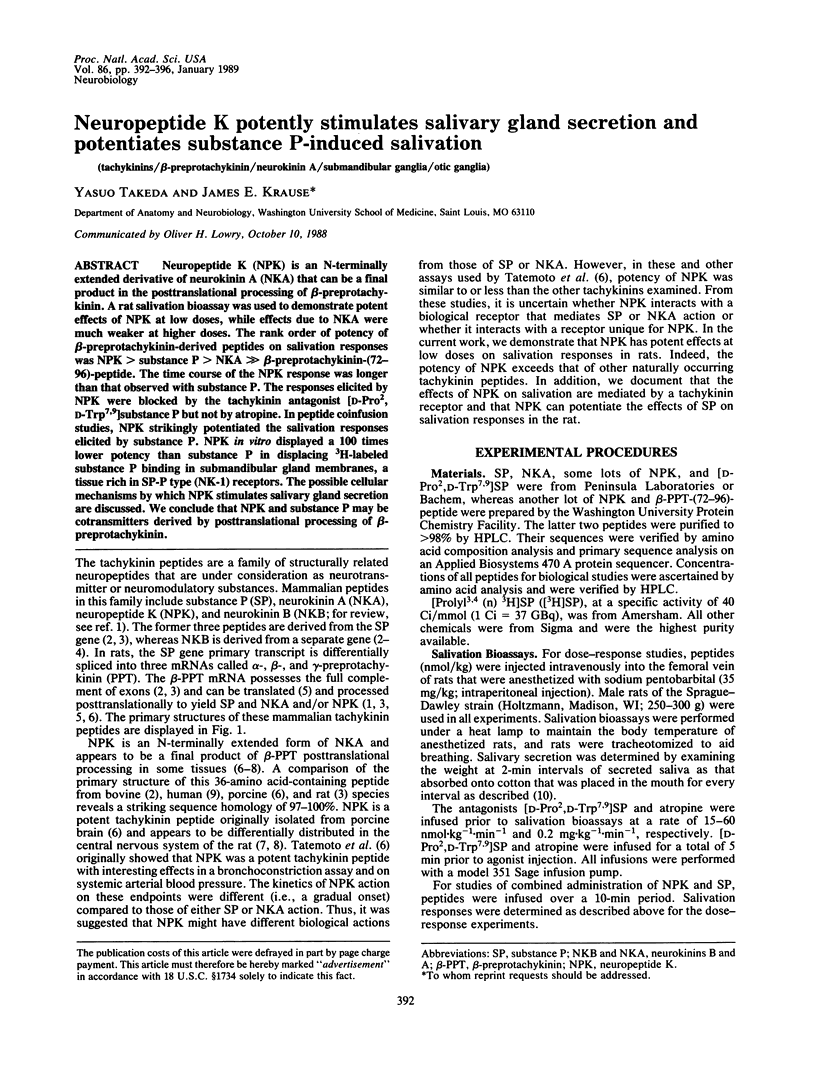
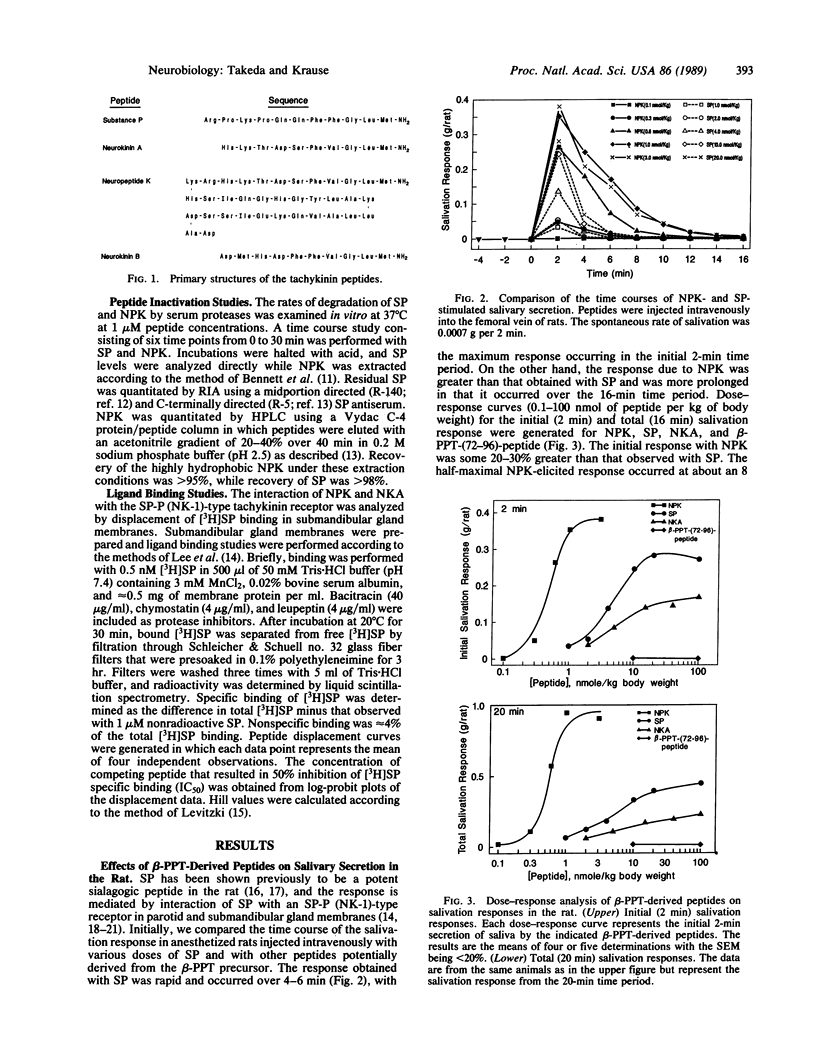
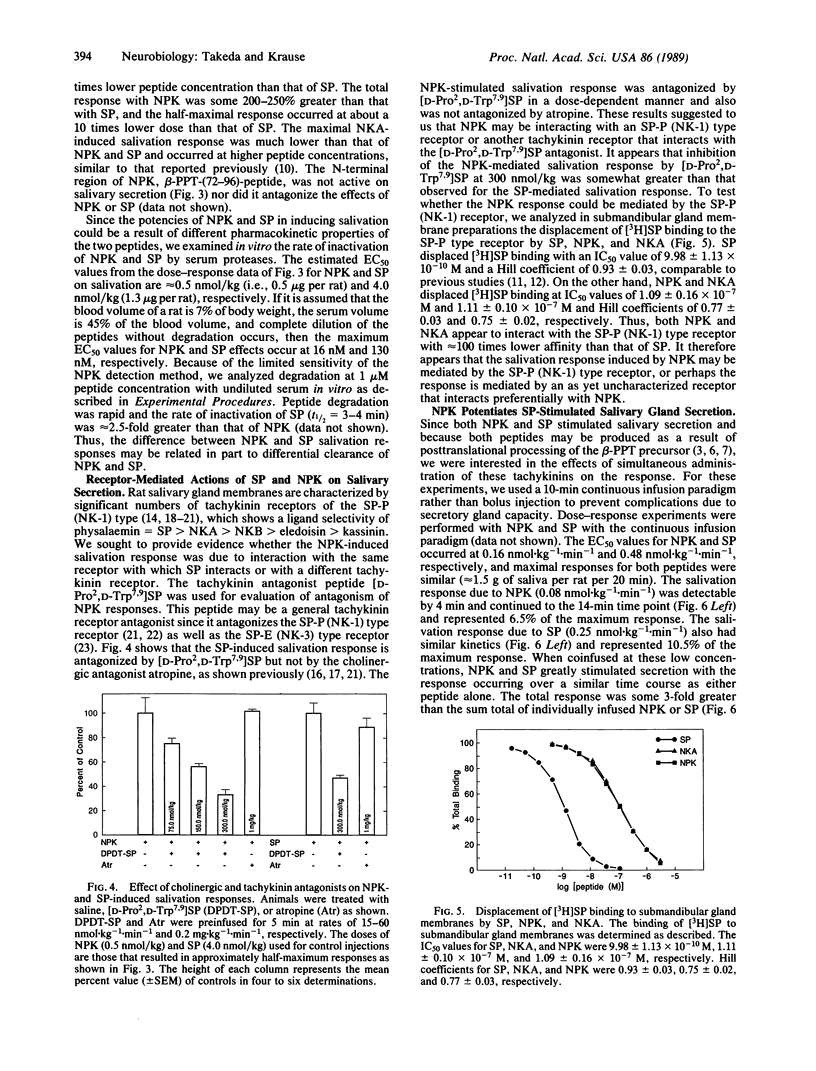
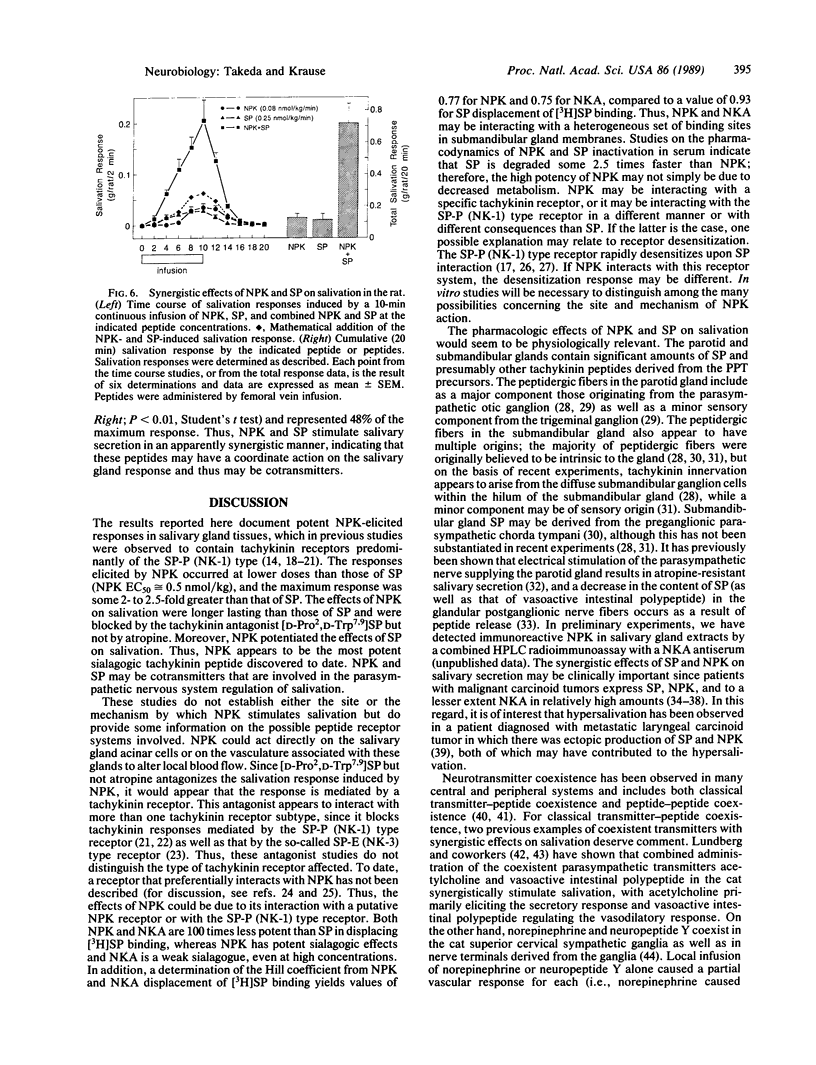
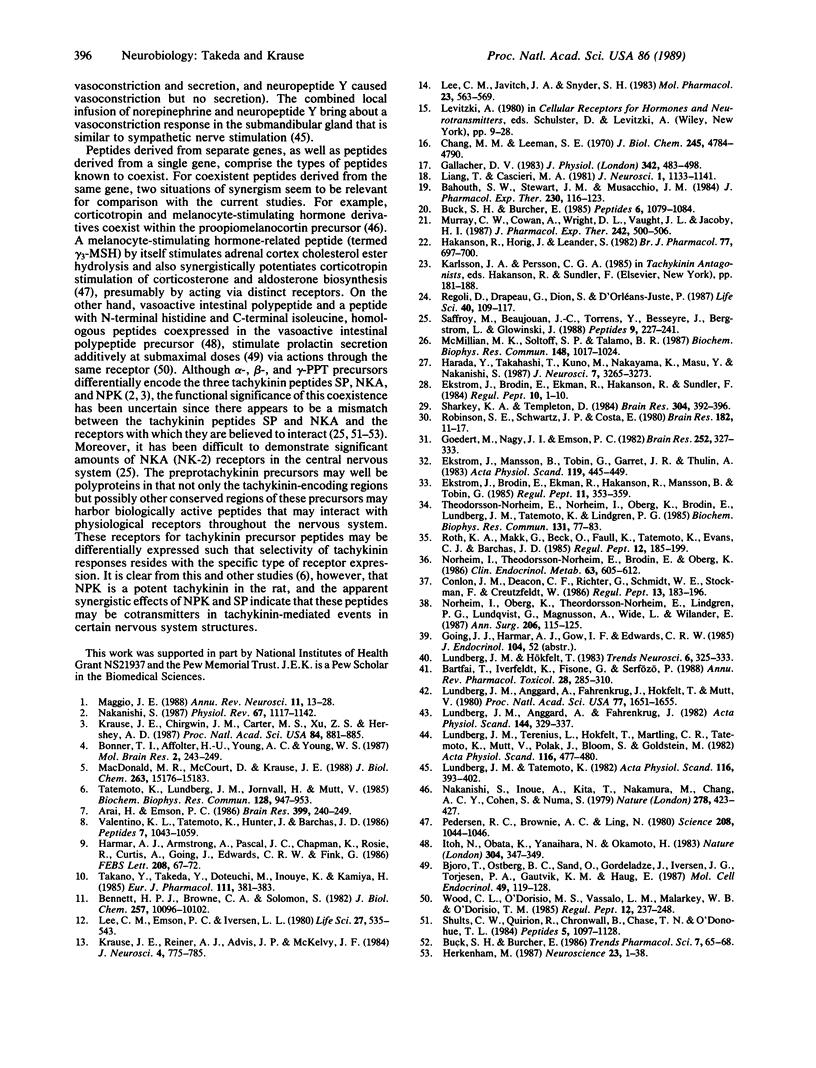
Images in this article
Selected References
These references are in PubMed. This may not be the complete list of references from this article.
- Arai H., Emson P. C. Regional distribution of neuropeptide K and other tachykinins (neurokinin A, neurokinin B and substance P) in rat central nervous system. Brain Res. 1986 Dec 10;399(2):240–249. doi: 10.1016/0006-8993(86)91514-3. [DOI] [PubMed] [Google Scholar]
- Bahouth S. W., Stewart J. M., Musacchio J. M. Specific binding of a 125I-labeled substance P analog to rat submaxillary gland. J Pharmacol Exp Ther. 1984 Jul;230(1):116–123. [PubMed] [Google Scholar]
- Bartfai T., Iverfeldt K., Fisone G., Serfözö P. Regulation of the release of coexisting neurotransmitters. Annu Rev Pharmacol Toxicol. 1988;28:285–310. doi: 10.1146/annurev.pa.28.040188.001441. [DOI] [PubMed] [Google Scholar]
- Bennett H. P., Browne C. A., Solomon S. Characterization of eight forms of corticotropin-like intermediary lobe peptide from the rat intermediary pituitary. J Biol Chem. 1982 Sep 10;257(17):10096–10102. [PubMed] [Google Scholar]
- Bjøro T., Ostberg B. C., Sand O., Gordeladze J., Iversen J. G., Torjesen P. A., Gautvik K. M., Haug E. Vasoactive intestinal peptide and peptide with N-terminal histidine and C-terminal isoleucine increase prolactin secretion in cultured rat pituitary cells (GH4C1) via a cAMP-dependent mechanism which involves transient elevation of intracellular Ca2+. Mol Cell Endocrinol. 1987 Feb;49(2-3):119–128. doi: 10.1016/0303-7207(87)90205-x. [DOI] [PubMed] [Google Scholar]
- Bonner T. I., Affolter H. U., Young A. C., Young W. S., 3rd A cDNA encoding the precursor of the rat neuropeptide, neurokinin B. Brain Res. 1987 Sep;388(3):243–249. doi: 10.1016/0169-328x(87)90031-3. [DOI] [PubMed] [Google Scholar]
- Buck S. H., Burcher E. The rat submaxillary gland contains predominantly P-type tachykinin binding sites. Peptides. 1985 Nov-Dec;6(6):1079–1084. doi: 10.1016/0196-9781(85)90431-0. [DOI] [PubMed] [Google Scholar]
- Chang M. M., Leeman S. E. Isolation of a sialogogic peptide from bovine hypothalamic tissue and its characterization as substance P. J Biol Chem. 1970 Sep 25;245(18):4784–4790. [PubMed] [Google Scholar]
- Conlon J. M., Deacon C. F., Richter G., Schmidt W. E., Stöckmann F., Creutzfeldt W. Measurement and partial characterization of the multiple forms of neurokinin A-like immunoreactivity in carcinoid tumours. Regul Pept. 1986 Jan;13(2):183–196. doi: 10.1016/0167-0115(86)90225-9. [DOI] [PubMed] [Google Scholar]
- Ekström J., Brodin E., Ekman R., Håkanson R., Månsson B., Tobin G. Depletion of neuropeptides in rat parotid glands and declining atropine-resistant salivary secretion upon continuous parasympathetic nerve stimulation. Regul Pept. 1985 Aug;11(4):353–359. doi: 10.1016/0167-0115(85)90207-1. [DOI] [PubMed] [Google Scholar]
- Ekström J., Brodin E., Ekman R., Håkanson R., Sundler F. Vasoactive intestinal peptide and substance P in salivary glands of the rat following denervation or duct ligation. Regul Pept. 1984 Dec;10(1):1–10. doi: 10.1016/0167-0115(84)90047-8. [DOI] [PubMed] [Google Scholar]
- Ekström J., Månsson B., Tobin G., Garrett J. R., Thulin A. Atropine-resistant secretion of parotid saliva on stimulation of the auriculo-temporal nerve. Acta Physiol Scand. 1983 Dec;119(4):445–449. doi: 10.1111/j.1748-1716.1983.tb07360.x. [DOI] [PubMed] [Google Scholar]
- Gallacher D. V. Substance P is a functional neurotransmitter in the rat parotid gland. J Physiol. 1983 Sep;342:483–498. doi: 10.1113/jphysiol.1983.sp014864. [DOI] [PMC free article] [PubMed] [Google Scholar]
- Goedert M., Nagy J. I., Emson P. C. The origin of substance P in the rat submandibular gland and its major duct. Brain Res. 1982 Dec 9;252(2):327–333. doi: 10.1016/0006-8993(82)90400-0. [DOI] [PubMed] [Google Scholar]
- Harada Y., Takahashi T., Kuno M., Nakayama K., Masu Y., Nakanishi S. Expression of two different tachykinin receptors in Xenopus oocytes by exogenous mRNAs. J Neurosci. 1987 Oct;7(10):3265–3273. doi: 10.1523/JNEUROSCI.07-10-03265.1987. [DOI] [PMC free article] [PubMed] [Google Scholar]
- Harmar A. J., Armstrong A., Pascall J. C., Chapman K., Rosie R., Curtis A., Going J., Edwards C. R., Fink G. cDNA sequence of human beta-preprotachykinin, the common precursor to substance P and neurokinin A. FEBS Lett. 1986 Nov 10;208(1):67–72. doi: 10.1016/0014-5793(86)81534-4. [DOI] [PubMed] [Google Scholar]
- Herkenham M. Mismatches between neurotransmitter and receptor localizations in brain: observations and implications. Neuroscience. 1987 Oct;23(1):1–38. doi: 10.1016/0306-4522(87)90268-5. [DOI] [PubMed] [Google Scholar]
- Håkanson R., Hörig J., Leander S. The mechanism of action of a substance P antagonist (D-Pro2, D-Trp7,9)-SP. Br J Pharmacol. 1982 Dec;77(4):697–700. doi: 10.1111/j.1476-5381.1982.tb09348.x. [DOI] [PMC free article] [PubMed] [Google Scholar]
- Krause J. E., Chirgwin J. M., Carter M. S., Xu Z. S., Hershey A. D. Three rat preprotachykinin mRNAs encode the neuropeptides substance P and neurokinin A. Proc Natl Acad Sci U S A. 1987 Feb;84(3):881–885. doi: 10.1073/pnas.84.3.881. [DOI] [PMC free article] [PubMed] [Google Scholar]
- Krause J. E., Reiner A. J., Advis J. P., McKelvy J. F. In vivo biosynthesis of [35S]- and [3H]substance P in the striatum of the rat and their axonal transport to the substantia nigra. J Neurosci. 1984 Mar;4(3):775–785. doi: 10.1523/JNEUROSCI.04-03-00775.1984. [DOI] [PMC free article] [PubMed] [Google Scholar]
- Lee C. M., Emson P. C., Iversen L. L. The development and application of a novel N-terminal directed substance P antiserum. Life Sci. 1980 Aug 18;27(7):535–543. doi: 10.1016/0024-3205(80)90302-1. [DOI] [PubMed] [Google Scholar]
- Lee C. M., Javitch J. A., Snyder S. H. 3h-substance P binding to salivary gland membranes. Regulation by guanyl nucleotides and divalent cations. Mol Pharmacol. 1983 May;23(3):563–569. [PubMed] [Google Scholar]
- Liang T., Cascieri M. A. Substance P receptor on parotid cell membranes. J Neurosci. 1981 Oct;1(10):1133–1141. doi: 10.1523/JNEUROSCI.01-10-01133.1981. [DOI] [PMC free article] [PubMed] [Google Scholar]
- Lundberg J. M., Anggård A., Fahrenkrug J. Complementary role of vasoactive intestinal polypeptide (VIP) and acetylcholine for cat submandibular gland blood flow and secretion. Acta Physiol Scand. 1982 Mar;114(3):329–337. doi: 10.1111/j.1748-1716.1982.tb06992.x. [DOI] [PubMed] [Google Scholar]
- Lundberg J. M., Anggård A., Fahrenkrug J., Hökfelt T., Mutt V. Vasoactive intestinal polypeptide in cholinergic neurons of exocrine glands: functional significance of coexisting transmitters for vasodilation and secretion. Proc Natl Acad Sci U S A. 1980 Mar;77(3):1651–1655. doi: 10.1073/pnas.77.3.1651. [DOI] [PMC free article] [PubMed] [Google Scholar]
- Lundberg J. M., Tatemoto K. Pancreatic polypeptide family (APP, BPP, NPY and PYY) in relation to sympathetic vasoconstriction resistant to alpha-adrenoceptor blockade. Acta Physiol Scand. 1982 Dec;116(4):393–402. doi: 10.1111/j.1748-1716.1982.tb07157.x. [DOI] [PubMed] [Google Scholar]
- Lundberg J. M., Terenius L., Hökfelt T., Martling C. R., Tatemoto K., Mutt V., Polak J., Bloom S., Goldstein M. Neuropeptide Y (NPY)-like immunoreactivity in peripheral noradrenergic neurons and effects of NPY on sympathetic function. Acta Physiol Scand. 1982 Dec;116(4):477–480. doi: 10.1111/j.1748-1716.1982.tb07171.x. [DOI] [PubMed] [Google Scholar]
- MacDonald M. R., McCourt D. W., Krause J. E. Posttranslational processing of alpha-, beta-, and gamma-preprotachykinins. Cell-free translation and early posttranslational processing events. J Biol Chem. 1988 Oct 15;263(29):15176–15183. [PubMed] [Google Scholar]
- Maggio J. E. Tachykinins. Annu Rev Neurosci. 1988;11:13–28. doi: 10.1146/annurev.ne.11.030188.000305. [DOI] [PubMed] [Google Scholar]
- McMillian M. K., Soltoff S. P., Talamo B. R. Rapid desensitization of substance P- but not carbachol-induced increases in inositol trisphosphate and intracellular Ca++ in rat parotid acinar cells. Biochem Biophys Res Commun. 1987 Nov 13;148(3):1017–1024. doi: 10.1016/s0006-291x(87)80233-4. [DOI] [PubMed] [Google Scholar]
- Murray C. W., Cowan A., Wright D. L., Vaught J. L., Jacoby H. I. Neurokinin-induced salivation in the anesthetized rat: a three receptor hypothesis. J Pharmacol Exp Ther. 1987 Aug;242(2):500–506. [PubMed] [Google Scholar]
- Nakanishi S., Inoue A., Kita T., Nakamura M., Chang A. C., Cohen S. N., Numa S. Nucleotide sequence of cloned cDNA for bovine corticotropin-beta-lipotropin precursor. Nature. 1979 Mar 29;278(5703):423–427. doi: 10.1038/278423a0. [DOI] [PubMed] [Google Scholar]
- Nakanishi S. Substance P precursor and kininogen: their structures, gene organizations, and regulation. Physiol Rev. 1987 Oct;67(4):1117–1142. doi: 10.1152/physrev.1987.67.4.1117. [DOI] [PubMed] [Google Scholar]
- Norheim I., Oberg K., Theodorsson-Norheim E., Lindgren P. G., Lundqvist G., Magnusson A., Wide L., Wilander E. Malignant carcinoid tumors. An analysis of 103 patients with regard to tumor localization, hormone production, and survival. Ann Surg. 1987 Aug;206(2):115–125. doi: 10.1097/00000658-198708000-00001. [DOI] [PMC free article] [PubMed] [Google Scholar]
- Norheim I., Theodorsson-Norheim E., Brodin E., Oberg K. Tachykinins in carcinoid tumors: their use as a tumor marker and possible role in the carcinoid flush. J Clin Endocrinol Metab. 1986 Sep;63(3):605–612. doi: 10.1210/jcem-63-3-605. [DOI] [PubMed] [Google Scholar]
- Pedersen R. C., Brownie A. C., Ling N. Pro-adrenocorticotropin/endorphin-derived peptides: coordinate action on adrenal steroidogenesis. Science. 1980 May 30;208(4447):1044–1046. doi: 10.1126/science.6246578. [DOI] [PubMed] [Google Scholar]
- Regoli D., Drapeau G., Dion S., D'Orléans-Juste P. Pharmacological receptors for substance P and neurokinins. Life Sci. 1987 Jan 12;40(2):109–117. doi: 10.1016/0024-3205(87)90349-3. [DOI] [PubMed] [Google Scholar]
- Robinson S. E., Schwartz J. P., Costa E. Substance P in the superior cervical ganglion and the submaxillary gland of the rat. Brain Res. 1980 Jan 20;182(1):11–17. doi: 10.1016/0006-8993(80)90826-4. [DOI] [PubMed] [Google Scholar]
- Roth K. A., Makk G., Beck O., Faull K., Tatemoto K., Evans C. J., Barchas J. D. Isolation and characterization of substance P, substance P 5-11, and substance K from two metastatic ileal carcinoids. Regul Pept. 1985 Nov 7;12(3):185–199. doi: 10.1016/0167-0115(85)90060-6. [DOI] [PubMed] [Google Scholar]
- Sadoul R., Hirn M., Deagostini-Bazin H., Rougon G., Goridis C. Adult and embryonic mouse neural cell adhesion molecules have different binding properties. 1983 Jul 28-Aug 3Nature. 304(5924):347–349. doi: 10.1038/304347a0. [DOI] [PubMed] [Google Scholar]
- Saffroy M., Beaujouan J. C., Torrens Y., Besseyre J., Bergström L., Glowinski J. Localization of tachykinin binding sites (NK1, NK2, NK3 ligands) in the rat brain. Peptides. 1988 Mar-Apr;9(2):227–241. doi: 10.1016/0196-9781(88)90255-0. [DOI] [PubMed] [Google Scholar]
- Sharkey K. A., Templeton D. Substance P in the rat parotid gland: evidence for a dual origin from the otic and trigeminal ganglia. Brain Res. 1984 Jun 25;304(2):392–396. doi: 10.1016/0006-8993(84)90346-9. [DOI] [PubMed] [Google Scholar]
- Shults C. W., Quirion R., Chronwall B., Chase T. N., O'Donohue T. L. A comparison of the anatomical distribution of substance P and substance P receptors in the rat central nervous system. Peptides. 1984 Nov-Dec;5(6):1097–1128. doi: 10.1016/0196-9781(84)90177-3. [DOI] [PubMed] [Google Scholar]
- Takano Y., Takeda Y., Doteuchi M., Inouye K., Kamiya H. Effect of a novel tachykinin, substance K, on salivation in rats. Eur J Pharmacol. 1985 May 20;111(3):381–383. doi: 10.1016/0014-2999(85)90646-6. [DOI] [PubMed] [Google Scholar]
- Tatemoto K., Lundberg J. M., Jörnvall H., Mutt V. Neuropeptide K: isolation, structure and biological activities of a novel brain tachykinin. Biochem Biophys Res Commun. 1985 Apr 30;128(2):947–953. doi: 10.1016/0006-291x(85)90138-x. [DOI] [PubMed] [Google Scholar]
- Theodorsson-Norheim E., Norheim I., Oberg K., Brodin E., Lundberg J. M., Tatemoto K., Lindgren P. G. Neuropeptide K: a major tachykinin in plasma and tumor tissues from carcinoid patients. Biochem Biophys Res Commun. 1985 Aug 30;131(1):77–83. doi: 10.1016/0006-291x(85)91772-3. [DOI] [PubMed] [Google Scholar]
- Valentino K. L., Tatemoto K., Hunter J., Barchas J. D. Distribution of neuropeptide K-immunoreactivity in the rat central nervous system. Peptides. 1986 Nov-Dec;7(6):1043–1059. doi: 10.1016/0196-9781(86)90134-8. [DOI] [PubMed] [Google Scholar]
- Wood C. L., O'Dorisio M. S., Vassalo L. M., Malarkey W. B., O'Dorisio T. M. Vasoactive intestinal peptide effects on GH3 pituitary tumor cells: high affinity binding, affinity labeling, and adenylate cyclase stimulation. Comparison with peptide histidine isoleucine and growth hormone-releasing factor. Regul Pept. 1985 Nov 7;12(3):237–248. doi: 10.1016/0167-0115(85)90065-5. [DOI] [PubMed] [Google Scholar]



